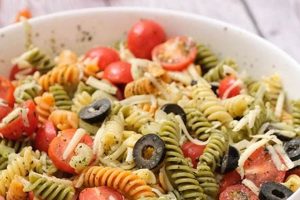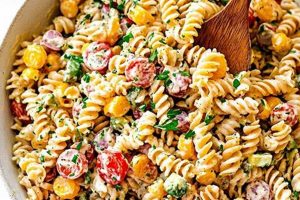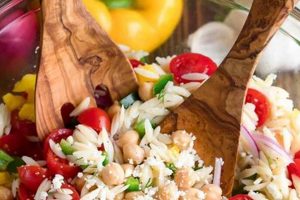Pasta salads crafted in the home kitchen offer a versatile and customizable culinary canvas. These dishes typically involve cooked pasta tossed with a variety of ingredients, including vegetables, proteins, cheeses, and dressings. A classic example might feature tri-color rotini, chopped bell peppers, cucumbers, black olives, cubed mozzarella, and a vinaigrette dressing.
Freshly prepared pasta salads provide control over ingredients, allowing for adjustments to dietary needs and preferences. This contrasts with commercially produced options, which may contain preservatives or excessive sodium. Furthermore, creating these dishes at home can be economical and reduces reliance on pre-packaged foods. Historically, pasta salads have evolved from simple combinations of pasta and vegetables to more complex and globally-inspired variations, reflecting culinary innovation and cultural exchange.
This exploration will delve further into key aspects of creating exceptional pasta salads, including selecting the right pasta shape, achieving balanced flavors through complementary ingredients, and mastering dressing techniques for optimal texture and taste.
Tips for Exceptional Pasta Salads
Crafting a delicious pasta salad involves more than simply tossing ingredients together. Attention to detail, from pasta selection to dressing preparation, elevates the final dish. The following tips offer guidance for achieving optimal results.
Tip 1: Select the Right Pasta. Shape and size influence the salad’s overall texture and ability to hold the dressing. Short, sturdy shapes like rotini, farfalle, or penne are ideal. Avoid long, thin pasta like spaghetti, which can become tangled and difficult to manage.
Tip 2: Cook Pasta Al Dente. Slightly firm pasta holds its shape better in a salad and prevents a mushy texture. Follow package directions, reducing the cooking time by a minute or two.
Tip 3: Rinse and Cool the Pasta. Rinsing cooked pasta with cold water stops the cooking process and removes excess starch, preventing the salad from becoming sticky. Ensure the pasta is completely cooled before adding other ingredients.
Tip 4: Embrace Variety with Ingredients. A medley of vegetables, proteins, and cheeses adds depth and complexity. Consider roasted vegetables, grilled chicken or shrimp, and crumbled feta or goat cheese.
Tip 5: Balance Flavors with the Dressing. The dressing should complement the other ingredients, not overpower them. Vinaigrettes, creamy dressings, or pesto can all be excellent choices, depending on the salad’s components.
Tip 6: Dress the Salad Shortly Before Serving. Adding the dressing too early can lead to soggy ingredients. Toss the salad with the dressing just before serving to maintain optimal texture and flavor.
Tip 7: Chill for Enhanced Flavor. Allowing the salad to chill for at least 30 minutes before serving allows the flavors to meld and intensify.
By following these tips, one can create pasta salads that are not only visually appealing but also offer a delightful balance of textures and flavors.
These practical insights provide a foundation for creating satisfying and memorable pasta salad experiences.
1. Pasta Variety
Pasta selection significantly influences the final character of a homemade pasta salad. The pasta’s shape, size, and texture interact with the other ingredients and the dressing, impacting both the aesthetic appeal and the overall eating experience. Understanding the nuances of various pasta types allows for informed choices that elevate the dish beyond the ordinary.
- Shape and Structure
Different pasta shapes offer varying surface areas and structural complexities. Shapes with crevices and folds, such as rotini, fusilli, or farfalle, effectively capture and hold dressings and smaller ingredients. Tubular shapes like penne and rigatoni offer a substantial bite, while smaller shapes like orzo and ditalini create a delicate texture. The chosen shape contributes to the salad’s visual appeal and how the ingredients combine.
- Size and Proportion
Pasta size should be considered in relation to the other ingredients. Larger pasta shapes pair well with robust additions like chunky vegetables or large protein pieces. Smaller pasta works better with finely diced ingredients and lighter dressings. Proportion is key to achieving a balanced and harmonious composition.
- Texture and Mouthfeel
The pasta’s texture plays a crucial role in the overall sensory experience. Al dente pasta provides a pleasant chewiness, while overcooked pasta can result in a mushy salad. The pasta’s texture interacts with the textures of other ingredients, such as crisp vegetables or creamy cheeses, creating a dynamic interplay.
- Gluten-Free and Alternative Options
Dietary considerations often necessitate alternative pasta choices. Gluten-free pasta, made from rice, corn, or quinoa, offers comparable versatility. Other options include lentil pasta or chickpea pasta, which contribute added protein and fiber. These alternatives allow for inclusive and adaptable recipes.
By carefully considering these facets of pasta variety, one can create homemade pasta salads that are not only visually appealing but also offer a delightful balance of textures and flavors. The choice of pasta becomes an integral part of the recipe’s success, contributing to a more satisfying and enjoyable culinary experience.
2. Fresh Ingredients
The hallmark of exceptional homemade pasta salad lies in the utilization of fresh, high-quality ingredients. These ingredients contribute not only vibrant flavors and appealing textures but also nutritional value, elevating the dish beyond a simple combination of components. Emphasis on freshness ensures a superior culinary experience.
- Seasonal Vegetables
Seasonal vegetables offer peak flavor and optimal nutritional content. Summer pasta salads benefit from ripe tomatoes, cucumbers, and bell peppers, while autumnal versions incorporate ingredients like butternut squash and Brussels sprouts. Selecting produce at its peak enhances both taste and visual appeal.
- Aromatic Herbs
Fresh herbs provide a depth of flavor that dried herbs often lack. Basil, parsley, oregano, and mint are excellent choices, imparting distinctive aromas and enhancing the overall complexity of the salad. Chopping herbs just before adding them to the salad maximizes their flavor contribution.
- High-Quality Proteins
Grilled chicken, shrimp, or flaked salmon introduce protein and enhance the salad’s nutritional value. These additions contribute textural variety and create a more substantial meal. Ensuring the quality and proper cooking of protein elements is crucial for food safety and optimal flavor.
- Artisan Cheeses
Freshly made cheeses, such as mozzarella, feta, or goat cheese, add depth and complexity to pasta salads. These cheeses contribute creamy textures and distinct flavor profiles, elevating the dish beyond standard supermarket varieties. The choice of cheese should complement the other ingredients and the chosen dressing.
The considered selection and incorporation of fresh, high-quality ingredients distinguish homemade pasta salads from pre-packaged or less thoughtfully prepared versions. Freshness elevates not only the sensory experience but also the nutritional value, resulting in a dish that is both satisfying and healthful. This emphasis on quality ingredients underscores the value of homemade preparation.
3. Flavorful Dressings
Dressings serve as the unifying element in homemade pasta salads, binding the diverse ingredients and imparting essential flavor. A well-crafted dressing elevates the dish beyond a simple assembly of components, transforming it into a cohesive and flavorful experience. Careful consideration of dressing choices is paramount to achieving a successful pasta salad.
- Balancing Acidity and Sweetness
The interplay of acidity and sweetness forms the foundation of a balanced dressing. Vinaigrettes, a classic choice, achieve this balance through the combination of vinegar and a sweetener like honey or maple syrup. The right balance enhances the flavors of the other ingredients without overpowering them. A slightly acidic dressing also helps to preserve the freshness of the salad.
- Complementing Ingredient Profiles
The dressing’s flavor profile should complement the other ingredients in the salad. A light and herbaceous vinaigrette pairs well with fresh vegetables and lighter proteins, while a creamy dressing, perhaps incorporating herbs or spices, complements heartier ingredients like roasted vegetables or grilled meats. Understanding these flavor dynamics is crucial for creating a harmonious dish.
- Texture and Emulsification
The dressing’s texture contributes significantly to the overall sensory experience. A smooth, emulsified vinaigrette coats the pasta and vegetables evenly, while a thicker, creamier dressing adds richness and body. The emulsification process, often involving whisking oil into vinegar, creates a stable and visually appealing dressing.
- Enhancing Flavor with Herbs and Spices
Fresh or dried herbs and spices add complexity and depth to dressings. Incorporating ingredients like oregano, basil, dill, or paprika enhances the overall flavor profile and allows for customization based on personal preferences and the salad’s other components. The judicious use of herbs and spices can transform a simple dressing into a culinary highlight.
The careful selection and preparation of a flavorful dressing are essential steps in crafting a truly exceptional homemade pasta salad. The dressing not only unites the various ingredients but also contributes significantly to the overall flavor profile and sensory experience. A well-balanced and complementary dressing transforms the individual components into a cohesive and delicious culinary creation.
4. Creative Add-ins
Distinctive add-ins elevate homemade pasta salads from predictable to exceptional. These additions introduce unexpected flavors, textures, and visual interest, transforming a simple dish into a culinary experience. Strategic incorporation of creative add-ins allows for personalized variations and reflects individual culinary preferences.
- Gourmet Cheeses and Cured Meats
Specialty cheeses, such as crumbled gorgonzola or smoked gouda, introduce complex flavor profiles. Cured meats, like prosciutto or salami, add savory notes and textural contrast. These additions contribute richness and depth, moving beyond standard cheese and protein choices.
- Roasted or Grilled Vegetables
Roasted vegetables, like bell peppers, zucchini, or asparagus, offer caramelized sweetness and smoky nuances. Grilling imparts similar char and intensifies flavors. These techniques enhance both flavor and visual appeal compared to raw vegetables.
- Nuts, Seeds, and Dried Fruits
Toasted nuts and seeds, such as pine nuts, walnuts, or sunflower seeds, provide satisfying crunch and nutty flavor. Dried fruits, like cranberries or apricots, introduce sweetness and chewiness. These additions create textural complexity and flavor contrasts.
- Unique Pantry Staples
Items like marinated artichoke hearts, olives, capers, or sun-dried tomatoes introduce distinct Mediterranean influences. These pantry staples provide convenience while enhancing flavor complexity. They also contribute salty, briny, or tangy notes that complement other ingredients.
Thoughtful incorporation of creative add-ins allows homemade pasta salads to become personalized culinary expressions. These additions contribute not only unique flavors and textures but also visual appeal, transforming a basic dish into a memorable experience. Such customization highlights the versatility and potential of homemade pasta salad recipes.
5. Proper Storage
Proper storage is crucial for maintaining the quality, safety, and flavor of homemade pasta salads. Improper storage can lead to bacterial growth, spoilage, and undesirable textural changes. The delicate balance of flavors and textures achieved through careful ingredient selection and preparation can be easily compromised by inadequate storage practices. For instance, a pasta salad containing mayonnaise-based dressing left at room temperature for an extended period becomes a breeding ground for bacteria, posing a significant health risk. Conversely, proper refrigeration in airtight containers preserves the salad’s freshness and prevents cross-contamination.
Effective storage begins with prompt refrigeration. After preparation, pasta salad should be cooled quickly and placed in airtight containers. This minimizes exposure to air and potential contaminants. Different components, such as dressings or particularly pungent ingredients, might be stored separately and combined just before serving to further preserve individual flavors and textures. Labeling containers with preparation dates ensures adherence to recommended storage durations, typically three to five days for most pasta salads. Freezing, while possible for some pasta salad variations, is generally not recommended as it can negatively affect the texture of certain ingredients.
Understanding and implementing proper storage techniques is integral to the successful execution of homemade pasta salad recipes. This practice not only preserves the culinary integrity of the dish but, more importantly, safeguards against foodborne illnesses. Careful attention to storage practices ensures that the effort invested in creating a flavorful and visually appealing pasta salad translates to a safe and enjoyable dining experience.
6. Dietary Adaptations
Dietary adaptations represent a crucial aspect of homemade pasta salad recipes, enabling customization to accommodate various individual needs and preferences. These adaptations extend beyond simple substitutions and often involve thoughtful consideration of ingredient interactions and overall nutritional balance. The ability to tailor recipes empowers individuals to enjoy pasta salads while adhering to specific dietary restrictions, promoting inclusivity and culinary satisfaction.
One common dietary adaptation involves addressing gluten sensitivities. Substituting traditional wheat-based pasta with gluten-free alternatives, such as those made from rice, corn, or quinoa, allows individuals with celiac disease or gluten intolerance to partake in this versatile dish. Further adaptations might involve ensuring that other ingredients, like sauces or dressings, are also gluten-free. Similarly, addressing dairy restrictions requires careful selection of cheeses and dressings. Vegan alternatives, such as cashew-based cheeses or plant-based yogurt dressings, offer comparable textures and flavors while adhering to vegan dietary principles. Managing other allergies or intolerances, such as nut allergies or sensitivities to specific vegetables, necessitates ingredient awareness and careful recipe adjustments.
Beyond specific dietary restrictions, homemade pasta salad recipes can be adapted to meet broader health goals. Incorporating whole wheat pasta increases fiber intake, promoting digestive health. Reducing the amount of oil in dressings or opting for lighter alternatives lowers overall fat content. Increasing the proportion of vegetables and lean protein sources enhances nutritional density. These adaptations highlight the versatility of homemade pasta salads in accommodating diverse dietary requirements and health objectives. Understanding and implementing such adaptations empowers individuals to personalize recipes while maintaining nutritional balance and culinary enjoyment.
Frequently Asked Questions
This section addresses common inquiries regarding the preparation and enjoyment of homemade pasta salads. Clarity on these points facilitates successful recipe execution and enhances the overall culinary experience.
Question 1: What is the best way to prevent pasta salad from becoming soggy?
Sogginess often results from dressing the salad too early or using excessive dressing. Dress the salad shortly before serving and consider adding ingredients with high water content, such as tomatoes, just before serving as well. Using slightly undercooked, al dente pasta also helps prevent excessive absorption of the dressing.
Question 2: How long can homemade pasta salad be stored safely?
Properly stored in an airtight container in the refrigerator, pasta salad typically remains safe to consume for three to five days. However, salads containing mayonnaise-based dressings or highly perishable ingredients may have a shorter shelf life.
Question 3: Can pasta salad be frozen?
Freezing is generally not recommended for pasta salad as it can negatively impact the texture of the pasta and other ingredients, particularly vegetables. Thawing can also lead to a watery consistency. It’s best to prepare and consume pasta salad within a few days.
Question 4: What are some suitable pasta shapes for pasta salad?
Short, sturdy pasta shapes like rotini, farfalle, penne, and fusilli work well in pasta salads as they hold their shape and capture the dressing effectively. Avoid long, thin pasta like spaghetti, which tends to become tangled and difficult to manage.
Question 5: How can one adapt pasta salad recipes for dietary restrictions?
Substitutions offer flexibility for various dietary needs. Gluten-free pasta can replace traditional pasta, while vegan dressings and cheese alternatives cater to plant-based diets. Adjustments to ingredients and dressings can also accommodate allergies or intolerances.
Question 6: What are some strategies for enhancing the flavor of pasta salad?
Utilizing fresh, high-quality ingredients is paramount. Fresh herbs, seasonal vegetables, and flavorful dressings contribute significantly to the overall taste. Incorporating creative add-ins, such as roasted vegetables, cured meats, or gourmet cheeses, further enhances the flavor profile.
Addressing these frequently asked questions provides a foundation for successful pasta salad preparation. Attention to detail, from ingredient selection to proper storage, ensures a safe and enjoyable culinary experience.
The following section will offer a collection of inspiring homemade pasta salad recipes to further explore the versatility and delicious possibilities of this culinary staple.
Homemade Pasta Salad Recipes
Exploration of homemade pasta salad recipes reveals a dish offering remarkable versatility and adaptability. From pasta selection and ingredient pairings to dressing choices and creative add-ins, the potential for customization is vast. Emphasis on fresh, high-quality ingredients, coupled with proper storage techniques, ensures both culinary satisfaction and food safety. Dietary adaptations further broaden accessibility, accommodating various individual needs and preferences.
Homemade pasta salad recipes represent more than a simple culinary undertaking; they embody a celebration of flavor, texture, and creative expression. Culinary exploration of this adaptable dish promises continued innovation and enjoyment for both novice cooks and seasoned chefs alike. The possibilities within the realm of homemade pasta salad recipes remain as diverse and exciting as the individuals who create them.






